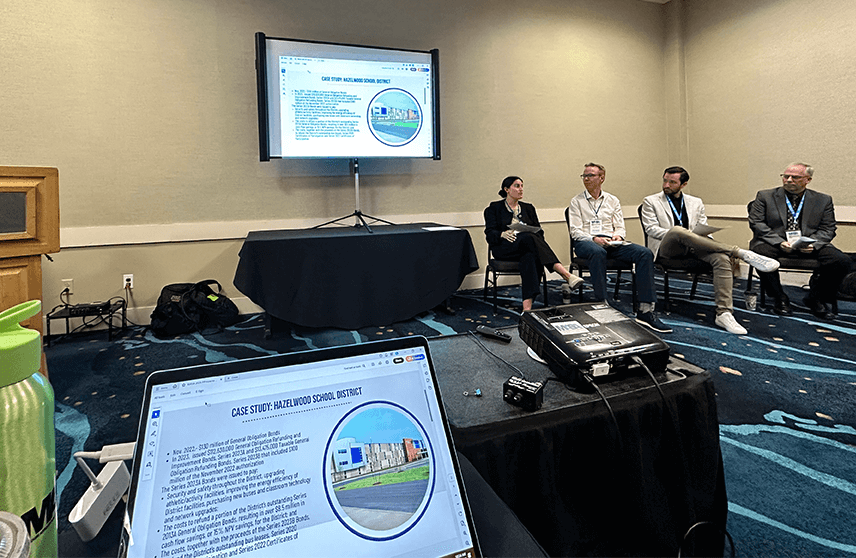

MASA Spring Conference – How to WIN Your Next Bond Issue Panelists (L to R): Kelly Esrock, STIFEL, Patrick Aylesworth, S. M. Wilson, Damien Schlitt, BLDD Architects and Chris Norman, Hazelwood Schools
At the Spring Missouri Association of School Administrators (MASA) Conference, a standing-room-only crowd gathered for a dynamic panel discussion designed to help guide school leaders through the complex journey of planning, passing, and executing a school bond issue.
The panel featured Chris Norman, CFO/Assistant Superintendent of Hazelwood School District; Rebecca Esrock, Director at Stifel; Damien Schlitt, AIA, LEED AP, Principal at BLDD Architects; and Patrick Aylesworth, LEED, Director of Operations at S. M. Wilson & Co. Their collective insights provided districts with a comprehensive look at overcoming challenges related to public perception, structuring bond financings effectively, and planning facilities for modern learning environments—all while maintaining transparency and community trust.
Key Challenges and How Districts Overcome Them
One of the most common hurdles districts face when pursuing a bond issue is public perception. Misinformation or a lack of engagement can lead to skepticism, making clear communication and early community involvement vital. Strategies such as open houses, renderings, data-driven messaging, and community visits—especially to retirement centers—have enabled districts to build support.
“Never use negative language,” one panelist advised. “It’s not a ‘no tax rate increase’—it’s a ‘zero tax rate impact.’ Words matter.”
Financial Strategy and Bond Timing
Esrock emphasized the importance of selecting a bond underwriter with more than transaction capabilities. “Underwriters offer critical financial projections and scenario planning that help districts determine what’s feasible,” she said.
She and Norman also addressed a common pitfall: poor timing.
In Missouri, bond issues require different voter thresholds depending on the month and whether it is an odd or even year. For example:
- Four-sevenths (57.14%) is the threshold for April elections, no matter the year.
- Four-sevenths (57.14%) is acceptable in August or November of even-numbered years.
- Two-thirds (66.7%) applies in odd-numbered years for all elections besides April.
Another consideration? Arbitrage. While a complex topic, arbitrage allows districts to maximize financial efficiency by reinvesting bond proceeds during the construction period. “It’s crucial to consult your bond expert on this,” Esrock added.
Early Engagement: Design and Construction
Damien Schlitt of BLDD Architects stressed that involving a design partner early—during facility assessments and program development—can guide critical decisions. Similarly, Patrick Aylesworth from S. M. Wilson emphasized that bringing a construction partner on board early ensures constructability and cost management.
“Construction delivery methods can significantly impact both budget and timeline,” said Aylesworth. “Districts need to evaluate which model—such as CMAR, Design-Build, or Design-Bid-Build—aligns best with their goals.”
Planning for Today’s Educational Needs
Schlitt also discussed the growing focus on flexible, collaborative, and technology-forward learning environments. “Today’s schools must support both traditional learning and future-ready skills,” he noted. This requires a planning approach that aligns pedagogy with physical space from the earliest stages.
Gaining and Sustaining Community Support
The panel offered tangible ideas for rallying community support:
- Build a strong digital presence (website, social media)
- Create high-quality visuals of proposed upgrades
- Visit community centers with students and staff
- Partner with local communication firms—ideally, those supporting community PACs
“Transparency is essential,” added Norman. Tools like board reports, financial dashboards, and public-facing websites help maintain trust.
Key Takeaways from Panelists
When asked for one lesson they would share with districts preparing a bond issue, panelists agreed early and ongoing engagement with partners and the community is critical.
“Don’t wait until after the bond passes to build buy-in,” Norman said. “You need your design, finance and construction partners at the table from the beginning.”
Real-World Examples: Bond Success Stories
Hazelwood School District
Voters approved Hazelwood’s $130 million bond in November 2022. The bond included improvements in security, athletics, energy efficiency, transportation, and technology. By refinancing existing debt and structuring the bonds effectively, the district saved over $8.5 million and unlocked $17.4 million in operational funds without changing the tax rate.
Pattonville School District
Pattonville began preparing years ahead of its successful April 2022 $111 million bond issue. In 2023, the district issued $50 million of such authorization and managed to secure broad investor interest with a 2031 optional redemption date that balanced future flexibility with obtaining the lowest cost of borrowing. The structure of the 2023 bonds allows the District to issue the remaining $61 million with no change to the debt service tax rate while managing interest rate risk.
St. Charles School District
Following a $50 million bond approval in April 2021, St. Charles structured its debt conservatively to preserve future capacity and flexibility. With strategic forecasting, the district funds capital improvements without increasing its debt service tax rate. This includes the recent passage of $90 million at the April 2025 election.

Panelists during the MASA Spring Conference session – How to WIN Your Next Bond Issue
Final Thoughts About Successfully Passing A Bond Issue
As this panel at MASA’s Spring Conference made clear, transparency, timing, and teamwork are the foundation of success. Passing and implementing a school bond issue is a multifaceted endeavor. Still, with the right partners, precise planning, and strong community engagement, it can transform educational environments without overburdening taxpayers.
Have additional questions about how S. M. Wilson can assist as your construction partner for your next bond issue? Contact Patrick Aylesworth at patrick.aylesworth@smwilson.com.
Ranked #34 by Building Design + Construction’s Top 100 K-12 School Construction Firms, S. M. Wilson’s expertise in Pre-K to 12th-grade education projects encompasses $2 billion in local work for more than 65 schools across 45+ school districts, including the construction of 6,000+ classrooms.
S. M. Wilson is a full-service construction management, design/build, and general contracting firm with offices in St. Louis, MO, and Edwardsville, IL. Founded in 1921, S. M. Wilson consists of dedicated professionals committed to exceeding client expectations. As a 100% employee-owned company, we take pride in our people-first approach and position as one of the leading construction management firms in the Midwest. For more information, visit www.smwilson.com.

